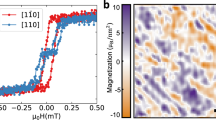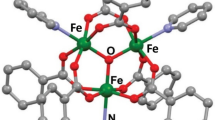Abstract
Quantum decoherence is a central concept in physics. Applications such as quantum information processing depend on understanding it; there are even fundamental theories proposed that go beyond quantum mechanics1,2,3, in which the breakdown of quantum theory would appear as an ‘intrinsic’ decoherence, mimicking the more familiar environmental decoherence processes4. Such applications cannot be optimized, and such theories cannot be tested, until we have a firm handle on ordinary environmental decoherence processes. Here we show that the theory for insulating electronic spin systems can make accurate and testable predictions for environmental decoherence in molecular-based quantum magnets5. Experiments on molecular magnets have successfully demonstrated quantum-coherent phenomena6,7,8 but the decoherence processes that ultimately limit such behaviour were not well constrained. For molecular magnets, theory predicts three principal contributions to environmental decoherence: from phonons, from nuclear spins and from intermolecular dipolar interactions. We use high magnetic fields on single crystals of Fe8 molecular magnets (in which the Fe ions are surrounded by organic ligands) to suppress dipolar and nuclear-spin decoherence. In these high-field experiments, we find that the decoherence time varies strongly as a function of temperature and magnetic field. The theoretical predictions are fully verified experimentally, and there are no other visible decoherence sources. In these high fields, we obtain a maximum decoherence quality-factor of 1.49 × 106; our investigation suggests that the environmental decoherence time can be extended up to about 500 microseconds, with a decoherence quality factor of ∼6 × 107, by optimizing the temperature, magnetic field and nuclear isotopic concentrations.
This is a preview of subscription content, access via your institution
Access options
Subscribe to this journal
Receive 51 print issues and online access
$199.00 per year
only $3.90 per issue
Buy this article
- Purchase on Springer Link
- Instant access to full article PDF
Prices may be subject to local taxes which are calculated during checkout



Similar content being viewed by others
References
't Hooft, G. Quantum gravity as a dissipative deterministic system. Class. Quantum Gravity 16, 3263–3279 (1999)
Penrose, R. On gravity's role in quantum state reduction. Gen. Relativ. Gravit. 28, 581–600 (1996)
Leggett, A. J. Testing the limits of quantum mechanics: motivation, state of play, prospects. J. Phys. Condens. Matter 14, R415–R451 (2002)
Stamp, P. C. E. The decoherence puzzle. Stud. Hist. Phil. Mod. Phys. 37, 467–497 (2006)
Gatteschi, D., Sessoli, R. & Villain, J. Molecular Nanomagnets (Oxford Univ. Press, 2006)
Takahashi, S. et al. Coherent manipulation and decoherence of S = 10 single-molecule magnets. Phys. Rev. Lett. 102, 087603 (2009)
Bertaina, S. et al. Quantum oscillations in a molecular magnet. Nature 453, 203–206 (2008)
Schlegel, C. et al. Direct observation of quantum coherence in single-molecule magnets. Phys. Rev. Lett. 101, 147203 (2008)
Leibfried, D., Blatt, R., Monroe, C. & Wineland, D. Quantum dynamics of single trapped ions. Rev. Mod. Phys. 75, 281–324 (2003)
Labaziewicz, J. et al. Temperature dependence of electric field noise above gold surfaces. Phys. Rev. Lett. 101, 180602 (2008)
Xu, X. et al. Optically controlled locking of the nuclear field via coherent dark-state spectroscopy. Nature 459, 1105–1109 (2009)
Ladd, T. D. et al. Pulsed nuclear pumping and spin diffusion in a single charged quantum dot. Phys. Rev. Lett. 105, 107401 (2010)
Takahashi, S. et al. Quenching spin decoherence in diamond through spin bath polarization. Phys. Rev. Lett. 101, 047601 (2008)
Childress, L. et al. Coherent dynamics of coupled electron and nuclear spin qubits in diamond. Science 314, 281–285 (2006)
Hanson, R. et al. Coherent dynamics of a single spin interacting with an adjustable spin bath. Science 320, 352–355 (2008)
Leggett, A. J. et al. Dynamics of the dissipative two-state system. Rev. Mod. Phys. 59, 1–85 (1987)
Prokof'ev, N. V. & Stamp, P. C. E. Theory of the spin bath. Rep. Prog. Phys. 63, 669–726 (2000)
Morello, A., Stamp, P. C. E. & Tupitsyn, I. S. Pairwise decoherence in coupled spin qubit networks. Phys. Rev. Lett. 97, 207206 (2006)
Wieghardt, K., Pohl, K., Jibril, I. & Huttner, G. Hydrolysis products of the monomeric amine complex (C6H15N3)FeCl3: the structure of the octameric iron(III) cation of [(C6H15N3)6Fe8(µ3–O)2(µ 2–OH)12]Br7 · 8H2O. Angew. Chem. Int. Edn Engl. 23, 77–78 (1984)
Hahn, E. L. Spin echoes. Phys. Rev. 80, 580–594 (1950)
van Tol, J., Brunel, L. C. & Wylde, R. J. A quasioptical transient electron spin resonance spectrometer operating at 120 and 240 GHz. Rev. Sci. Instrum. 76, 074101 (2005)
Morley, G. W., Brunel, L. C. & van Tol, J. A multifrequency high-field pulsed electron paramagnetic resonance/electron-nuclear double resonance spectrometer. Rev. Sci. Instrum. 79, 064703 (2008)
Stamp, P. C. E. & Tupitsyn, I. S. Coherence window in the dynamics of quantum nanomagnets. Phys. Rev. B 69, 014401 (2004)
Yao, W., Liu, R. B. & Sham, L. J. Theory of electron spin decoherence by interacting spins in a quantum dot. Phys. Rev. B 74, 195301 (2006)
Morello, A., Bakharev, O. N., Brom, H. B., Sessoli, R. & de Jongh, L. J. Nuclear Spin Dynamics in the Quantum regime of a single molecule magnet. Phys. Rev. Lett. 93, 197202 (2004)
Cuccoli, A. et al. Dipolar interaction and incoherent quantum tunneling: a Monte Carlo study of magnetic relaxation. Europhys. J. B. 12, 39–46 (1999)
Tupitsyn, I. S., Stamp, P. C. E. & Prokofev, N. V. Hole digging in ensembles of tunneling molecular magnets. Phys. Rev. B 69, 132406 (2004)
Hill, S. et al. D-strain, g-strain, and dipolar interactions in the Fe8 and Mn12 single molecule magnets: an EPR lineshape analysis. Int. J. Mod. Phys. B 16, 3326–3329 (2002)
Park, K. et al. Effects of D-strain, g-strain, and dipolar interactions on EPR linewidths of the molecular magnets Fe8 and Mn12 . Phys. Rev. B 65, 014426 (2001)
Barra, A. L., Gatteschi, D. & Sessoli, R. High-frequency EPR spectra of [Fe8O2(OH)12(tacn)6]Br8: a critical appraisal of the barrier for the reorientation of the magnetization in single-molecule magnets. Chem. Eur. J. 6, 1608–1614 (2000)
Acknowledgements
This work was supported by the NSF (DMR-0520481, DMR-0703925), the Keck Foundation (S.T. and J.v.T.), NSERC, CIFAR, PITP, the John E. Fetzer Memorial Trust (grant D21-C62) and the Center for Philosophy and the Natural Sciences, California State University, Sacramento (I.S.T. and P.C.E.S.). The National High Magnetic Field Laboratory is supported by NSF Cooperative Agreement DMR-0654118, by the State of Florida, and by the DOE.
Author information
Authors and Affiliations
Contributions
S.T., I.S.T. and P.C.E.S. contributed to the writing of the manuscript. S.T., I.S.T. and P.C.E.S. conceived the ESR experiments. The ESR measurements were carried out by S.T. and J.v.T. The theoretical work was done by I.S.T. and P.C.E.S. C.C.B and D.N.H. synthesized Fe8 crystals and performed X-ray diffraction measurements.
Corresponding authors
Ethics declarations
Competing interests
The authors declare no competing financial interests.
Supplementary information
Supplementary Information
The file contains Supplementary Methods and Data, Supplementary Figures 1-2 with legends and additional references. (PDF 283 kb)
Rights and permissions
About this article
Cite this article
Takahashi, S., Tupitsyn, I., van Tol, J. et al. Decoherence in crystals of quantum molecular magnets. Nature 476, 76–79 (2011). https://doi.org/10.1038/nature10314
Received:
Accepted:
Published:
Issue Date:
DOI: https://doi.org/10.1038/nature10314
This article is cited by
-
Coherent manipulation and quantum phase interference in a fullerene-based electron triplet molecular qutrit
npj Quantum Information (2021)
-
Measuring molecular magnets for quantum technologies
Nature Reviews Physics (2021)
-
Quantum learning with noise and decoherence: a robust quantum neural network
Quantum Machine Intelligence (2020)
-
Molecular spins for quantum computation
Nature Chemistry (2019)
-
Enhancing coherence in molecular spin qubits via atomic clock transitions
Nature (2016)
Comments
By submitting a comment you agree to abide by our Terms and Community Guidelines. If you find something abusive or that does not comply with our terms or guidelines please flag it as inappropriate.



